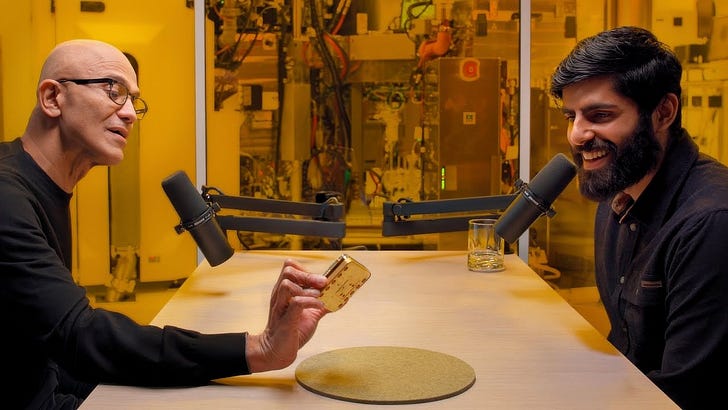Satya Nadella on Microsoft AI/AGI, Agents, Quantum Computing, Future of Tech
Notes on the recent convo between Satya Nadella & Dwarkesh
In a recent convo between Microsoft CEO Satya Nadella and Dwarkesh Patel, Nadella outlines the company’s latest dual breakthroughs: (1) a Majorana-based quantum chip and (2) a generative gaming model, Muse — with details published in Nature (links below).
Quantum Computing: Interferometric single-shot parity measurement in InAs–Al hybrid devices
Generative Gaming: World and Human Action Models towards gameplay ideation
My take? Premature hype… but this is expected for anything “AI” and “quantum” in 2025. If Microsoft were actually using the quantum chip to potentially do something useful, I’d be excited. Same with if they’d already used the “generative gaming model” to create a popular game.
Until the rubber meets the road… it’s mostly a stepping stone en route to potentially being useful in the real world. (We cannot assume that quantum computing will deliver… it probably will, but who knows when.)
In the convo, Nadella reflects on tech shifts in the 80s and 90s and explains how lessons from the past are shaping Microsoft’s full-stack strategy today, spanning from client-server computing to the expansive realms of cloud & AI.
From my perspective, anytime you get a long-form interview with the CEO of a major tech company on the cutting-edge of AI/HPC — it’s worth a listen regardless of whether you like the company. I listened to most of the interview but it’s pretty long… so I documented key segments and specific points.
Microsoft is a rock-solid company and their stock performance has historically been elite. From an investment perspective, they’ve been lagging/chopping sideways the past ~1 year (MSFT stock) but this is irrelevant in the big picture.
Key Interview Segments:
Dual Breakthroughs: Microsoft announced Muse (a generative AI for gaming) and the Majorana Zero Chip (a quantum computing breakthrough).
Muse Highlights: Generates persistent, adaptive game worlds in real time using gameplay data—leveraging Microsoft’s deep gaming legacy.
Quantum Breakthrough: The Majorana One chip promises 1 million physical qubits, potentially enabling utility‑scale quantum computing by 2027–2029.
Lessons from History: Insights from the client‑server and web eras underscore the importance of pairing technological innovation with smart business models.
Future of AI & Compute: Hyperscale providers like Azure will drive exponential compute demand, with AI revenue expected to skyrocket.
Work Transformation: AI tools (e.g., Copilot) are set to transform knowledge work, shifting workflows and augmenting human decision‑making.
Cultural Resilience: Microsoft’s “refounding” mindset and long‑term R&D approach ensure ongoing relevance and innovation.
1. AI Breakthrough: Muse (World Human Action Models)
Overview: Microsoft announced the Muse model—a generative AI system designed to create consistent, diverse, and persistent game environments by leveraging extensive gameplay data.
Significance:
Persistent & Adaptive Worlds: Muse can generate dynamic game worlds that continuously adapt to user modifications, potentially revolutionizing game development.
Data-Driven Consistency: Similar to how DALL-E and Sora generate images and videos, Muse uses real gameplay data to maintain consistency in output.
Real-Time Demonstration: The model demonstrated real-time capability by producing consistent outputs based on Xbox controller inputs.
Legacy in Gaming: Building on a rich history (e.g., Microsoft's early success with Flight Simulator even before Windows), Muse leverages deep gaming data assets, positioning Microsoft as a key player not only in gaming but also in generative AI.
Applications:
Game Catalog Expansion: Microsoft plans to integrate Muse into its gaming portfolio to create a diverse catalog of games.
General Action/World Model: The model may also serve as a universal action and world model—analogous to how YouTube’s data underpins Google’s ecosystem—enhancing both gaming experiences and potentially other interactive media.
Strategic Context:
Core Focus on Gaming: With significant investments in IP acquisitions and cloud gaming platforms, Microsoft views high-quality gaming as an end in itself.
Transformative Potential: AI in gaming is seen as a transformative moment akin to the CGI revolution, emphasizing that technical breakthroughs must be coupled with quality content.
2. Quantum Computing Breakthrough: Majorana Zero Chip
Overview: Microsoft announced a breakthrough with the Majorana zero chip, which leverages Majorana zero modes—a new phase of matter—for building more reliable qubits.
Significance:
Transistor Moment for Quantum: The chip is a key step toward a utility‑scale quantum computer, similar to how the transistor revolutionized classical computing.
Robust Qubits: Majorana zero modes enable qubits that are inherently less noisy and more scalable.
Massive Scale Potential: The Majorana One chip is designed to support 1 million physical qubits and thousands of error‑corrected logical qubits.
Timeline and Goals:
Fault-Tolerant Systems: Microsoft aims to build a fault‑tolerant quantum computer by 2027–2029, based on this fabrication breakthrough.
Complementary Role: Quantum computing is expected to complement classical computing—excelling in data‑light, exploration‑heavy tasks like chemical physics and biology simulations.
Applications:
Integration with HPC and AI: Quantum systems will be integrated with high-performance computing (HPC) stacks and AI, allowing for quantum simulations that generate synthetic data to train better models in materials science, chemistry, and biology.
API Access and Research: Future quantum capabilities are envisioned to be accessible via APIs, with internal use driving breakthroughs in materials science and chemistry.
Research Approach:
Long-Term Commitment: Microsoft’s quantum efforts span 30 years, with this breakthrough validating its topological qubit strategy.
Collaborative Platforms: In parallel, Microsoft collaborates with teams working on neutral atom, ion trap, and photonic quantum approaches—having already achieved 24 logical qubits with error correction.
3. Lessons from Past Technological Shifts

Parallels with the 1980s and 1990s
Client‑Server Era:
Debates & Decisions: Nadella recalls early debates over RISC vs. CISC and the eventual dominance of x86 servers, which underpinned the success of Windows NT.
Full‑Stack Transformation: Microsoft’s recognition of scale advantages in client‑server applications set the stage for integrated operating systems, networking, and application layers.
Web and Browser Era:
Market Disruption: The arrival of Mosaic and Netscape in 1993 challenged Microsoft’s client‑server dominance.
Adaptation & Missed Opportunities: While Microsoft quickly embraced HTML (integrated into Word, Internet Explorer, and web servers), it missed capturing the search business model—a gap that Google exploited.
Key Lessons:
Tech Trends vs. Business Models: Success requires not only understanding technological trends but also identifying where real value is created.
Adapting to Shifts: Just as the cloud revolution transformed client‑server computing, AI and quantum represent a full‑stack shift requiring agile adaptation.
4. Predictions on Value Creation in AI
A.) Hyperscalers as Winners
Exponential Compute Demand:
Agent Multiplier Effect: AI workloads—especially with multi‑agent systems that trigger cascading tasks—will dramatically increase compute needs.
Infrastructure Leadership: Hyperscalers like Microsoft Azure, with a global fleet (spanning over 60 regions), are ideally positioned to support training, test‑time compute, and inference.
Infrastructure Needs:
Integrated Systems: AI’s efficiency depends on a balanced integration of accelerators, storage, and standard compute—all designed for high utilization in distributed environments.
Revenue Projections:
Scaling Up: Current AI revenue stands at $13 billion annually, with projections suggesting it could reach $130 billion in four years if current trends persist.
Investment Governor: Inference revenue is seen as a key metric that ensures supply and demand are properly balanced.
B.) Model Layer Dynamics
Competition and Open Source:
Diverse Ecosystem: Nadella foresees that the model layer will not be monopolized; open‑source alternatives will challenge closed‑source offerings, especially as enterprise buyers demand multiple suppliers.
Regulatory Influence:
Government Oversight: Anticipated regulation will further moderate the possibility of winner‑take‑all scenarios.
Market Nuances:
Consumer vs. Enterprise: While consumer markets may experience winner‑take‑all network effects (as seen with ChatGPT’s rapid rise), enterprise markets will feature category‑specific winners based on diverse buyer needs.
C.) Jevons' Paradox and Elastic Demand
Cost-Driven Expansion:
Cheaper Intelligence Drives Demand: Lower costs per token (a phenomenon explained by Jevons’ Paradox) will spur an explosion of use cases, as observed in cloud adoption.
Efficiency Breakthroughs: Advances like DeepSeek’s models shift the performance‑per‑token frontier, making AI even more valuable.
Global Impact:
Transformative Use Cases: In regions like the Global South, cheaper tokens could revolutionize sectors such as healthcare and education, while enterprises discover new demand opportunities.
5. Challenges in Deploying AI in Enterprises
A.) Change Management and Process Change
Transforming Knowledge Work:
Lean for Knowledge: Just as Lean Methodology transformed manufacturing, AI is set to revolutionize knowledge work by automating routine tasks and reshaping workflows.
Real-World Examples: Nadella uses Copilot to prepare for podcasts by generating summaries and coordinating team communications, illustrating the shift from manual to AI‑assisted work.
Deployment Bottlenecks:
Compliance & Scalability: Large enterprises face significant challenges around compliance and scalability when deploying AI at scale.
Sandboxing and Safety: Ensuring AI systems operate within controlled, sandboxed environments is critical—underscored by lessons from incidents like the early Sydney Bing experience.
Alignment and Delegated Authority: AI systems must remain aligned with human oversight, with legal frameworks in place to hold humans accountable for AI actions.
B.) Future of Knowledge Work
Agent Management:
New Interfaces: Nadella envisions a future “agent manager” interface—beyond simple chat—that orchestrates multiple AI agents handling various tasks, exceptions, and notifications.
SaaS Transformation:
Evolving Business Logic: Traditional SaaS applications (Office, Teams, CRM) will evolve as AI agents shift core business logic to an agentic layer, unlocking significant value and addressing IT backlogs.
6. Societal and Economic Impact of AI

A.) Economic Growth as a Benchmark
Real Growth vs. Hype:
Measuring Impact: Nadella cautions against AGI hype, insisting that true success is measured by tangible economic growth—potentially raising GDP in developed economies from stagnant 2% nominal (or 0% real) to 5–10%.
Broad Industry Benefits:
Beyond Tech Revenue: The transformative power of AI will benefit the entire economy, not just the tech sector, by driving productivity across industries.
B.) Legal and Social Structures
Trust and Liability:
Frameworks for Safety: Advanced AI requires robust legal and social frameworks to ensure trust and indemnification, with human oversight always in control.
Mitigating Rogue Behavior:
Global Order: Despite potential rogue actors, global legal and political structures are expected to limit misuse and ensure accountable deployment.
C.) Labor and Cognitive Work
Shifting Dynamics:
Evolving Labor Needs: While AI may automate routine cognitive tasks (e.g., email triage), it will also create new forms of high-value work.
Augmentation, Not Replacement: AI is seen as a cognitive amplifier that enhances human decision-making and helps overcome bounded rationality in complex environments.
7. Microsoft's Research and Innovation Approach
A.) Curiosity-Driven Research
Microsoft Research (MSR): Founded in 1995, MSR emphasizes fundamental, curiosity‑driven research, accepting that many bets won’t pay off immediately but may benefit future leadership.
Scaling Innovations:
From Lab to Market: The challenge is not only in breakthrough research but in scaling these innovations into commercially viable products—a process that requires strong judgment and a supportive culture.
B.) Strategic Bets and Long-Term Vision
3 Big Bets:
AI, Quantum, Mixed Reality: Nadella highlights these as key focus areas. While mixed reality faces social adoption challenges (e.g., wearable devices), the synergy between AI and quantum computing promises transformative breakthroughs.
Accelerating Progress:
Compressed Industrial Revolution: Nadella envisions that quantum and AI together could accelerate advancements in materials science and chemistry—compressing 250 years of progress into just 25 years.
Wide-Ranging Applications: Expected impacts include sustainable materials, healthcare innovations, and even interplanetary travel.
8. Microsoft's Culture & Longevity
A.) Relevance Over Longevity
50th Anniversary Milestone: Microsoft, now 50 years old, remains a leader despite the youth of most tech giants—underscoring that ongoing relevance, not age, defines success.
Refounding Mindset: Nadella champions a “refounder mode,” where employees are encouraged to challenge core assumptions and continuously re-architect the business.
B.) Employee Engagement and Future Aspirations
Cultural Strength: Microsoft’s success stems from creating a platform that offers both economic rewards and a sense of purpose—evidenced by Nadella’s own 34‑year tenure.
Retaining Future Leaders: A high tolerance for failure and speculative R&D investments are key to nurturing future talent and sustaining innovation.
Underserved Domains: If Nadella were to leave Microsoft, he’d focus on applying technological abundance (tokens per dollar per watt) to underserved areas like healthcare, education, and the public sector.
Additional Insights
AI & AGI Definitions
AGI Skepticism: Nadella questions conventional definitions of AGI, arguing that automating current tasks creates new forms of cognitive labor rather than ending human work.
Human-AI Coexistence: Rather than replacing humans, AI will augment our cognitive abilities—serving as a facilitator in meetings and decision-making processes.
Potential AI on Microsoft's Board
Facilitator Role in Governance: Nadella envisions AI serving as a facilitator during board meetings—using long-term memory and contextual analysis to keep discussions focused.
Augmentation Not Replacement: While AI can enhance decision-making, it will never replace the nuanced judgment of human board members.
My thoughts on the Nadella & Dwarkesh convo…
Muse & quantum computing: Cool. Stepping stones to potential breakthroughs in real-world use cases.
No guarantees but favorable developments and exciting enough to generate media buzz/hype.
At this point MSFT is probably #2 in quantum computing behind Google’s Willow chip (but they are different types of quantum so this isn’t a 1:1 comparison).
Other “pure-play” quantum computing companies will have their hands full trying to take on Google, Microsoft, IBM, etc.
I’d guess that Nadella is a bit optimistic on the quantum timelines and integration with HPC/AI, but I hope I’m wrong.
Microsoft history: Discusses missing the search wave and losing to Google Search & AdSense, etc. By the time MSFT joined the party they were too late with Bing… they had plenty of wins though.
AI & future work: Nadella believes AI revenue will increase significantly and AI agents will become a big part of the workforce. This seems accurate. He envisions humans controlling/directing agents to enhance productivity — but thinks AI will complement humans not replace. (I agree in the near-term, vehemently disagree in the long-term).
Enterprise & consumer AI: Nadella thinks that big enterprise will diversify between AI providers (makes sense), but that consumer markets could experience "winner take all" type paradigm.
A winner-takes-all could happen, but one AI lab would really need to out-accelerate the others to a significant degree… if any "walls of diminishing returns” are hit, others catch up (or leapfrog if they think of the next paradigm quicker). (Read: Beyond AI Inference Scaling Limits)
I think people will have their favorite AIs and/or play musical chairs — hopping to whoever offers the best all-around product.
AI & Jevons Paradox: It makes sense to think that Jevons paradox is occurring for AI and will continue. AI is becoming lower cost and delivering higher performance each year — by a significant degree. This means that AI use will continue expanding… whether Jevons paradox applies to hardware or a specific company like NVIDIA is a different debate that wasn’t discussed.
AGI = 10% Annual GDP Growth: Nadella’s definition of AGI is AI that generates 10% GDP growth per year. I think this is a bad “definition” for AGI (makes zero sense)… but it could be a “side effect” or part of a “criteria” for AGI.
AGI is whatever you want it to be and there are so many different definitions it’s pointless to have debates. My issue with Nadella here is that you could have elite level AI (i.e. “AGI”) but theoretically be incapable of translating its impact to the economy. Sure it’s unlikely, but not impossible.
Intelligence doesn’t automatically equal economic growth. I’d argue that a potential criterion for elite-level AGI could be growth of “true GDP” or “innovation-specific GDP.”
I’d also argue that “AGI” is not static (there are levels to it and may overlap with ASI). Everyone has their own definitions. 10 years ago most would agree that what we have with OpenAI’s o3, xAI’s Grok 3, et al. are AGI.
I understand Nadella’s probable intent was to imply that everyone needs to pump the brakes on the AI/AGI hype train… I agree with this sentiment re: standalone AI. Human augmentation with AI in terms of productivity should accelerate discoveries. Many erroneously market this as “AI discovers x-y-z” or “solves proof a-b-c”… these are junk headlines… the AI was an augmenter not a lone wolf Einstein (it will eventually get there though).



